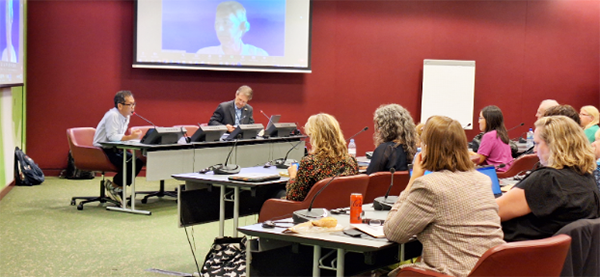The Secretariat of the Southeast Asian Fisheries Development Center (SEAFDEC) and the CITES Secretariat have jointly published two guides to facilitate the identification of shark and ray species common in the Southeast Asian region.
The purpose of the guides is to provide an accessible tool to help fisheries officers, fisheries researchers, CITES authorities and other relevant stakeholders in identifying sharks and rays commonly found in the Southeast Asian region.
The guides, collectively named the Pocket Field Guide: sharks and rays in Southeast Asian region, contain photographs and summary descriptions of the most commonly found 25 species of rays and 25 species of sharks.
The average sizes of each species, their scientific and common names, and their status under CITES and in the IUCN Red List are also included in the guides. Color photographs and drawings are provided for each species with highlighted arrows on the main identifying characteristics. The images of “look-alike” species are arranged in the same page or the following adjacent pages for easy comparison.
 |
Pocket Field Guide: Sharks in Southeast Asian Region |
 |
Pocket Field Guide: Rays in Southeast Asian Region |
 |
Sharks Poster |
 |
Rays Poster |
The selections of species and the pictures used in the guides were taken from the series of regional and national data collection efforts under supervision of international shark and ray specialists. These were namely Dr. Ahmad bin Ali, Chief of SEAFDEC Marine Fishery Resources Development and Management Department and Regional Vice Chair of the IUCN Shark Specialist Group for South East Asia Region, and Mr. Dharmadi, member of the IUCN Shark Specialist Group and Sharks Expert from the Ministry of Marine Affairs and Fisheries of Indonesia.
Additionally, the project also contributed to an “Identification Guide to Sharks, Rays, Skates and Chimaeras of the Southeast Asian Region Vol.2,” which contains 50 species of sharks, 30 species of rays, 6 species of skates and 4 species of chimaeras found in Southeast Asia.
The guides were developed through the series of prior activities carried out by the SEAFDEC Secretariat in collaboration with SEAFDEC Training Department and SEAFDEC Marine Fishery Resources Development and Management Department, with support from the CITES Secretariat, aimed at assisting SEAFDEC Member Countries in meeting CITES provisions for international trade in commercially valuable, CITES-listed shark and ray specimens.
With financial support for the European Union, the CITES Secretariat conducted a project in 2017-2020 to support Parties with the implementation of the Convention’s provisions for marine species. To this end, it partnered with SEAFDEC in the Southeast Asian region.
The development of the guides stems from decisions adopted at the Seventeenth Meeting of the Conference of the Parties to CITES (CoP 17, 2016). These included Decision 17.210 and 17.214, tasking the CITES Secretariat with making guidance and identification materials for sharks and rays available to Parties and relevant stakeholders, and encouraging Parties and Regional Fisheries Organizations such as SEAFDEC to “consider making CITES-listed species a priority for data collection”.
As a partner, SEAFDEC organized a regional data validation workshop in October 2019, building on the previous shark data collection activities in Cambodia and Myanmar during 2015 and 2016.
With joint funding from the EU-CITES project and the Government of Japan, SEAFDEC also organized the compilation of sharks landing data in Cambodia, Indonesia, Malaysia, Myanmar, Thailand and Viet Nam for 2015–2016 and 2018-2019. Published in September 2020, the results of these research efforts helped develop the identification materials in the guides, inter alia by informing which species of sharks and rays are most commonly landed in the region.
CITES Secretary-General Ivonne Higuero welcomed the Pocket Field Guide, saying: “We believe the information in these new guides will greatly support efforts to conserve CITES-listed marine species from overfishing in South East Asia, thus contributing to ensure fisheries in the region can remain sustainable. As Parties continue to discuss the potential listing of additional marine species and the implications for fisheries and fishing communities, tools like these guides and SEAFDEC’s technical reports can only support Parties in implementing the Convention and achieving its conservation and sustainable use objectives.”
SEAFDEC Secretary-General and Chief of SEAFDEC Training Department, Ms. Malinee Smithrittee, expressed her views on the importance of capacity development on species identification of elasmobranch species, saying: “The sustainable utilization of multi-species fisheries resources in Southeast Asia requires enhanced knowledge and skills of concerned fisheries officials and relevant researchers to correctly identify the species for understanding the stock status of such resources. These guides and other technical publications of SEAFDEC are envisioned to motivate and facilitate the improvement of fisheries stocks management including the vulnerable species of sharks and rays.
 SEAFDEC Southeast Asian Fisheries Development Center
SEAFDEC Southeast Asian Fisheries Development Center

